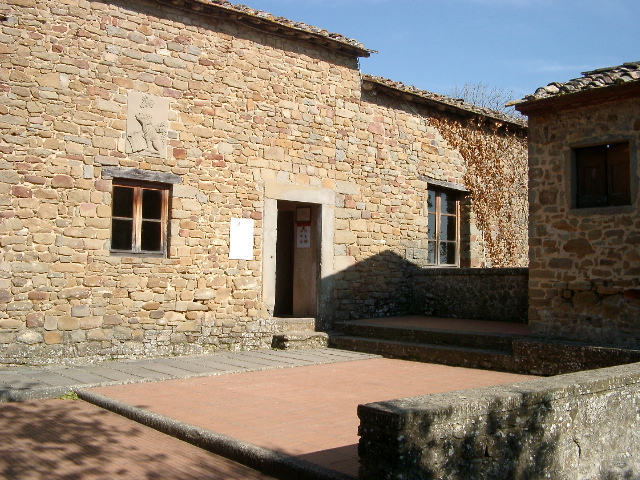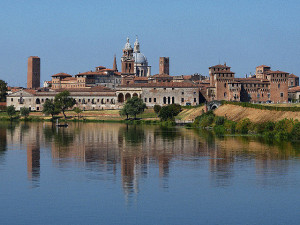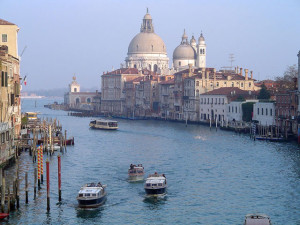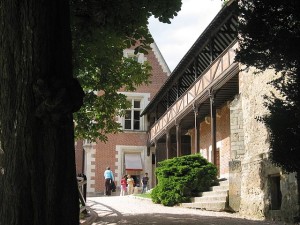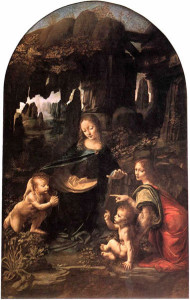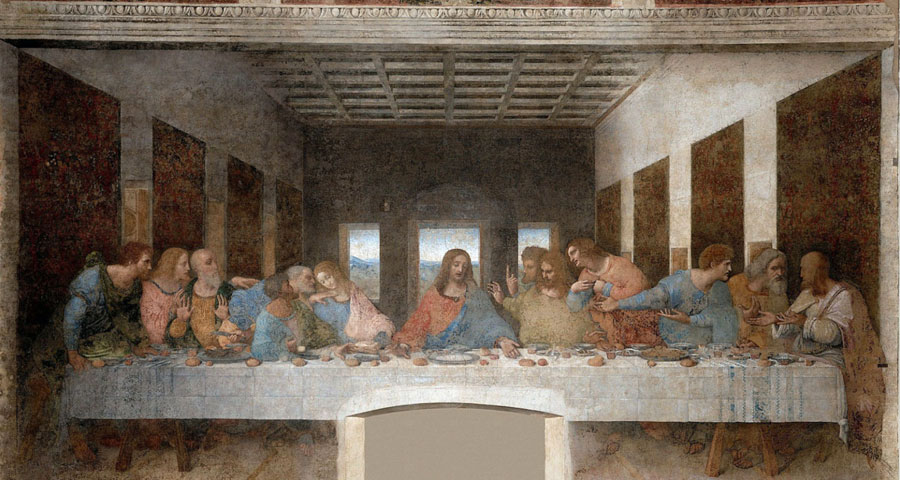Nasce a Vinci (Firenze) nel 1452. Apprendista nella bottega del Verrocchio , lavora con lui per circa 10 anni.
Lascia Firenze nel 1482 per entrare al servizio di Ludovico il Moro, signore di Milano. Qui in pochi anni realizza due dei suoi capolavori:
la Vergine delle rocce, che presenta la Madonna col Bambino in un ambiente originale, fatto di rocce,
l’Ultima cena in cui coglie i sentimenti che travolgono i discepoli quando Gesù dice che uno di loro lo tradirà.
Caduta Milano in mano dei Francesi, passa a Mantova, poi a Venezia ed infine a Firenze.
Dipinge la celebre Gioconda, che rappresenta il suo ideale di equilibrio e serenità.
Nei 1506 ritorna a Milano e si dedica alla progettazione di opere idrauliche (i Navigli) e allo studio della sue “macchine”.
Nel 1516 lascia l’Italia e si trasferisce a Cloux, ospite di Francesco I re di Francia, per cui progetta il bellissimo castello di Romorantin.
A Cloux muore nel 1519.
Leonardo scienziato
Gli studi e i progetti scientifici di Leonardo ci sono giunti attraverso un migliaia di fogli manoscritti, in cui sono raccolti le tavole, i disegni e gli appunti dello scienziato.
Il gruppo più consistente è conservato nel prezioso Codice Atlantico,che si trova alla Biblioteca Ambrosiana di Milano.
I settori di ricerca a cui si dedica sono molteplici; anatomia, biologia, fisica e astronomia. L’originalità del suo pensiero lo porta ad anticipare i principi sui quali si fonderà la scienza nuova di Galileo. Egli infatti dà molta importanza all’esperienza e sostiene la necessità che tutto ciò che uno studioso afferma debba potere essere verificato.
Attività
- Presenta ai tuoi compagni il ritratto della Gioconda. Devi dire:
- chi è l’autore;
- quando viene realizzata l’opera;
- che cosa rappresenta;
- che cosa si vede sullo sfondo;
- che impressioni suscita il volto della donna.
- Leggi il testo su Leonardo scienziato e spiega qual è il principio fondamentale su cui si basa la sua attività di studioso.
- Fai una ricerca in Internet sulle “macchine” di Leonardo e prepara un cartellone illustrato da presentare in classe.
The Virgin of the Rocks is the name used for two paintings by Leonardo da Vinci, of the same subject, and of a composition which is identical except for several significant details. The version generally considered the prime version, that is the earlier of the two, hangs in The Louvre in Paris and the other in the National Gallery.
The Last Supper is a late 15th-century mural painting by Leonardo da Vinci in the refectory of the Convent of Santa Maria della Grazie, Milan. The work is presumed to have been commenced around 1495 and was commissioned as part of a scheme of renovations to the church and its convent buildings by Leonardo’s patron Ludovico Sforza, Duke of Milan. The painting represents the scene of The Last Supper of Jesus with his disciples, as it is told in the Gospel of John, 13:21. Leonardo has depicted the consternation that occurred among the Twelve Disciples when Jesus announced that one of them would betray him.
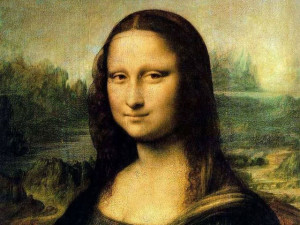 The Mona Lisa, La Gioconda, is a half-length portrait of a woman by the Italian artist Leonardo da Vinci, which has been acclaimed as “the best known, the most visited, the most written about, the most sung about, the most parodied work of art in the world.”
The Mona Lisa, La Gioconda, is a half-length portrait of a woman by the Italian artist Leonardo da Vinci, which has been acclaimed as “the best known, the most visited, the most written about, the most sung about, the most parodied work of art in the world.”
The painting, thought to be a portrait of Lisa Gherardini, the wife of Francesco del Giocondo, is in oil on a poplar panel, and is believed to have been painted between 1503 and 1506, although Leonardo may have continued working on it as late as 1517. It was acquired by King Francis I of France and is now the property of the French Republic, on permanent display at the Musée du Louvre in Paris since 1797. The ambiguity of the subject’s expression, which is frequently described as enigmatic, the monumentality of the composition, the subtle modeling of forms and the atmospheric illusionism were novel qualities that have contributed to the continuing fascination and study of the work.
APPROFONDIMENTI
IN-DEPTH
Apprendista nella bottega del Verrocchio = In 1466, at the age of fourteen, Leonardo was apprenticed to the artist Andrea di Cione, known as Verrocchio, whose workshop was “one of the finest in Florence”. Other famous painters apprenticed or associated with the workshop include Domenico Ghirlandaio, Perugino, Botticelli, and Lorenzo di Credi. Leonardo would have been exposed to both theoretical training and a vast range of technical skills including drafting, chemistry, metallurgy, metal working, plaster casting, leather working, mechanics and carpentry as well as the artistic skills of drawing, painting, sculpting and modelling.
Much of the painted production of Verrocchio’s workshop was done by his employees. According to Vasari, Leonardo collaborated with Verrocchio on his The Baptism of Christ, painting the young angel holding Jesus’ robe in a manner that was so far superior to his master’s that Verrocchio put down his brush and never painted again.
Verrocchio = Andrea del Verrocchio born Andrea di Michele di Francesco de’ Cioni, was an Italian sculptor, goldsmith and painter who worked at the court of Lorenzo de’ Medici in Florence in the early renaissance. Few paintings are attributed to him with certainty, but a number of important painters were trained at his workshop.
Ludovico il Moro, signore di Milano = Ludovico Maria Sforza, also known as Ludovico il Moro; 27 July 1452 – 27 May 1508, was Duke of Milan from 1489 until his death. A member of the Sforza family, he was the fourth son of Francesco Sforza. He was famed as a patron of Leonardo da Vinci and other artists, and presided over the final and most productive stage of the Milanese Renaissance. He is probably best known as the man who commissioned the The Last Supper.
Opere idaruliche = Leonardo’s journals include a vast number of inventions, both practical and impractical. They include musical instruments, hydraulic pumps, reversible crank mechanisms, finned mortar shells, and a steam cannon.
Cloux = The Château du Clos Lucé is a small château in the city of Amboise, France. The place is famous for being the official residence of Leonardo da Vinci between 1516 and 1519. Clos Lucé is located at 500 metres from the royal Château d’Amboise, to which it is connected by an underground passageway.
Francesco I re di Francia = In 1516, King Francis I of France invited Leonardo da Vinci to Amboise and provided him with the Clos Lucé, then called Château de Cloux, as a place to stay and work. Leonardo, a famous painter and inventor, arrived with three of his paintings, namely the Mona Lisa, Sainte Anne, and Saint Jean Baptiste. Leonardo lived at the Clos Lucé for the last three years of his life, and died there on 2 May 1519.
Castello di Romorantin = Marcel Reymond suggested that Leonardo da Vinci, a guest of François at Clos Lucé near Amboise, was responsible for the original design, which reflects Leonardo’s plans for a château at Romorantin for the King’s mother, and his interests in central planning and double helical staircases; the discussion has not yet concluded.
Codice Atlantico = The Codex Atlanticus (Atlantic Codex) is a twelve-volume, bound set of drawings and writings by Leonardo da Vinci, the largest such set; its name indicates its atlas-like breadth. It comprises 1,119 leaves dating from 1478 to 1519, the contents covering a great variety of subjects, from flight to weaponry to musical instruments and from mathematics to botany. This codex was gathered by the sculptor Pompeo Leoni, son of Leone Leoni, in the late 16th century, although Leoni dismembered some Leonardo notebooks in its formation. It is currently preserved at the Biblioteca Ambrosiana in Milan.
Biblioteca Ambrosiana di Milano = The Biblioteca Ambrosiana is a historic library in Milan, Italy, also housing the Pinacoteca Ambrosiana, the Ambrosian art gallery, it was founded by Cardinal Federico Borromeo (1564–1631).
Cardinal Borromeo gave his collection of paintings and drawings to the library, too. Shortly after the cardinal’s death, his library acquired twelve manuscripts of Leonardo da Vinci, including the Codex Atlanticus. The library now contains some 12,000 drawings by European artists, from the 14th through the 19th centuries.
Galileo Galilei = Galileo Galilei, 15 February 1564 – 8 January 1642, was an Italian physicist, mathematician, astronomer, and philosopher who played a major role in the Scientific Revolution. His achievements include improvements to the telescope and consequent astronomical observations and support for Copernicanism. Galileo has been called the “father of modern observational astronomy”, the “father of modern physics”, the “father of science”, and “the Father of Modern Science”.
Suggerimenti per l’insegnante:
- Si consiglia di osservare i dipinti o le opere d’arte proposte per un primo impatto visivo con esse. I ragazzi devono essere sollecitati ad esprimere impressioni, sensazioni provate di fronte alle opere. Si suggerisce che questo avvenga nella loro lingua madre in modo che non vi siano limiti o difficoltà nel cogliere e nel trasmettere le proprie emozioni.
- A questo punto, dopo il primo contatto con le opere d’arte, si propone la lettura dei testi in italiano a voce alta da parte di uno o più studenti.
- La classe viene sollecitata a porre domande di approfondimento o di chiarimento su quanto letto.
- Gli approfondimenti in lingua inglese costituiscono un supporto valido e necessario ad una espansione della conoscenza; sono tuttavia da considerare un materiale di consultazione non indispensabile, ma facilitatore, del testo in italiano.
- La traduzione di alcuni termini al passaggio del mouse favorisce gli studenti nel loro lavoro di lettura e comprensione.
- Solo a questo punto vengono proposte le attività da svolgere in modo collettivo con la partecipazione di tutti gli studenti e quindi con il massimo degli interventi e della comunicazione da parte di tutti.
- Al termine della lezione si consiglia di chiedere agli studenti, a livello individuale o a livello di piccolo gruppo, lo svolgimento di una relazione su quanto appreso.
- Si suggerisce di stampare la scheda di arte e di raccoglierla insieme alle altre, in modo che possano essere consultate dai ragazzi, durante la realizzazione della loro relazione.
- Le schede di arte comprendono anche la descrizione di alcune città che costituiscono il contesto entro il quale l’artista ha vissuto o dove è collocata la sua opera.
- I video sono un contributo ad una maggiore comprensione dei dati culturali e della lingua italiana utilizzato.

 PORTALE
PORTALE TUTORIAL
TUTORIAL